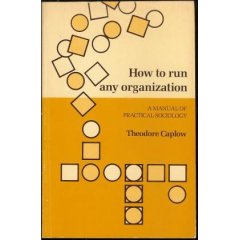I’ve got a book on my bookshelf that I’ve had for years titled How To Run Any Organization, by Theodore Caplow. The clever title caught my attention and I snatched it up from the used bookstore I frequented during my pecuniary seminary days. I was eager to learn any secrets it could reveal as I was heading off to my first administrative job. Never having been in a position of primary leadership in any organization I was hoping for a crash course in “how to succeed in business without really trying.â€

Books and articles that promise to unlock the secrets of success are plentiful. They shamelessly promise insight without the effort of thinking, success with little effort, wisdom without the trial of experience, and winning with no risk. Most of those books are not much more than a notch above snake oil in print. And they succeed because snake oil will always sell (heck, I bought the book, didn’t I?).
But the better books of this sort are those that strive to address “the fundamentals.†They identify the basics about leadership while avoiding the promise of magical solutions, silver bullets, or silly metaphors that substitute for insight. The more responsible authors share genuine insight culled from the experience of failure and of lessons learned in the school of hard knocks. They value excellence over success and find more satisfaction in the practice of integrity than the bottom line.
I was culling my files the other day and came across an article I’d saved from a 2003 issue of The Economist titled, “How to run a company well.â€
The article lists “a ten-point checklist of the necessary qualities†of effective leadership. Here’s the list:
- A sound ethical compass
- The ability to take [sic] unpleasant decisions
- Clarity and focus
- Ambition
- Effective communication skills
- The ability to judge people
- A knack for developing talent
- Emotional self-confidence
- Adaptability
- Charm.
You can read the entire article on the website of The Economist magazine (you’ll have to sign in). What do you think?
- Is there something missing that you’d add to the list?
- Is there something on the list you don’t agree with?
- In the context of congregational leadership, would the list be different? How so?
- Does this list apply to those who occupy “second chair†leadership positions? Is their list different?

